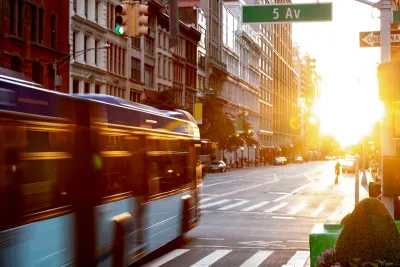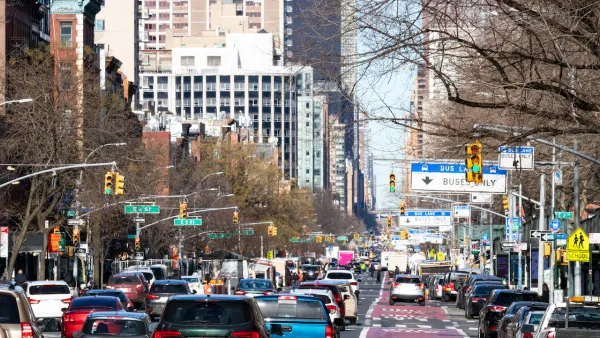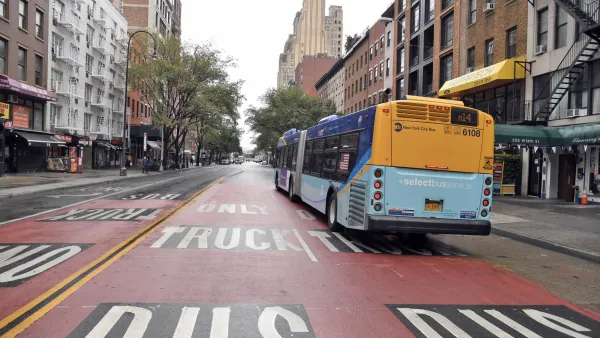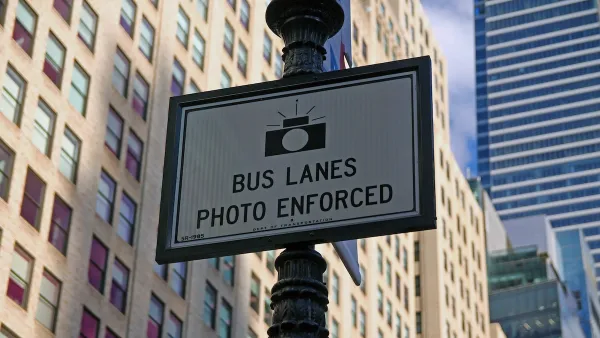Sharing lanes with car traffic may make it impossible for the MTA to increase service frequency.

Bus frequency in New York City is hindered by congestion, writes Dave Colon in Streetsblog NYC, making it practically impossible for the Metropolitan Transportation Authority (MTA) to meet a goal of improving frequency by 20 percent.
Buses will never beat a subway in terms of the total number of people one bus can move compared to a full subway train. But that doesn't mean buses need to provide significantly less bang for their buck, which is what happens when they're caught in a sea of double parked cars and trucks parked in the bus lane.
One potential solution is ramping up the use of automated enforcement to cite drivers who block bus lanes. “ABLE [Automated Bus Lane Enforcement] cameras have improved bus speeds by 5 percent on routes where they're used, and faster buses are of course one way to get more bus service for less money, as the Citizens Budget Commission pointed out in a policy brief on MTA finances in the dark days of 2021.” Yet New York’s buses are moving at the same speed now as in 2018—7.5 miles per hour.
Redesigning inefficient bus routes could also help speed up service. “City bus stops are notoriously close together compared to international peers, which means buses are constantly stopping and starting. The buses also run on long and circuitous routes that haven't been updated in decades, forcing drivers to navigate tight streets and wait out traffic to make left turns.”
Meanwhile, “A spokesperson for the MTA did not dispute the tenor of the budget negotiations, but focused on the fact that the transit system survived at all.”
FULL STORY: City Traffic Helps Make Bus Service Unbearable, Expensive And Difficult To Improve

National Parks Layoffs Will Cause Communities to Lose Billions
Thousands of essential park workers were laid off this week, just before the busy spring break season.

Retro-silient?: America’s First “Eco-burb,” The Woodlands Turns 50
A master-planned community north of Houston offers lessons on green infrastructure and resilient design, but falls short of its founder’s lofty affordability and walkability goals.

Delivering for America Plan Will Downgrade Mail Service in at Least 49.5 Percent of Zip Codes
Republican and Democrat lawmakers criticize the plan for its disproportionate negative impact on rural communities.

Test News Post 1
This is a summary

Test News Headline 46
Test for the image on the front page.

Balancing Bombs and Butterflies: How the National Guard Protects a Rare Species
The National Guard at Fort Indiantown Gap uses GIS technology and land management strategies to balance military training with conservation efforts, ensuring the survival of the rare eastern regal fritillary butterfly.
Urban Design for Planners 1: Software Tools
This six-course series explores essential urban design concepts using open source software and equips planners with the tools they need to participate fully in the urban design process.
Planning for Universal Design
Learn the tools for implementing Universal Design in planning regulations.
EMC Planning Group, Inc.
Planetizen
Planetizen
Mpact (formerly Rail~Volution)
Great Falls Development Authority, Inc.
HUDs Office of Policy Development and Research
NYU Wagner Graduate School of Public Service





























